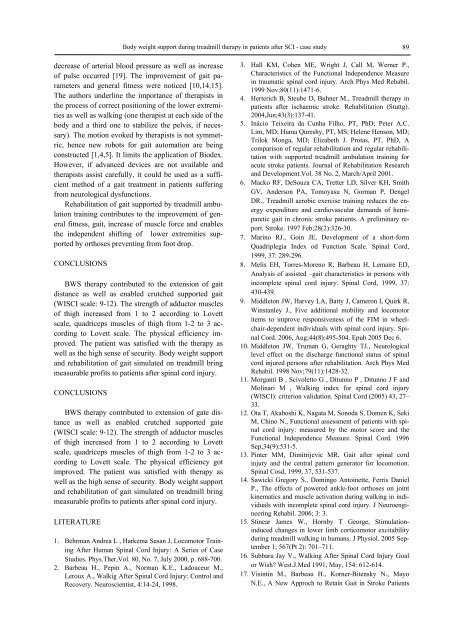medical and biological sciences - Collegium Medicum - Uniwersytet ...
medical and biological sciences - Collegium Medicum - Uniwersytet ...
medical and biological sciences - Collegium Medicum - Uniwersytet ...
You also want an ePaper? Increase the reach of your titles
YUMPU automatically turns print PDFs into web optimized ePapers that Google loves.
Body weight support during treadmill therapy in patients after SCI - case study 89decrease of arterial blood pressure as well as increaseof pulse occurred [19]. The improvement of gait parameters<strong>and</strong> general fitness were noticed [10,14,15].The authors underline the importance of therapists inthe process of correct positioning of the lower extremitiesas well as walking (one therapist at each side of thebody <strong>and</strong> a third one to stabilize the pelvis, if necessary).The motion evoked by therapists is not symmetric,hence new robots for gait automation are beingconstructed [1,4,5]. It limits the application of Biodex.However, if advanced devices are not available <strong>and</strong>therapists assist carefully, it could be used as a sufficientmethod of a gait treatment in patients sufferingfrom neurological dysfunctions.Rehabilitation of gait supported by treadmill ambulationtraining contributes to the improvement of generalfitness, gait, increase of muscle force <strong>and</strong> enablesthe independent shifting of lower extremities supportedby orthoses preventing from foot drop.CONCLUSIONSBWS therapy contributed to the extension of gaitdistance as well as enabled crutched supported gait(WISCI scale: 9-12). The strength of adductor musclesof thigh increased from 1 to 2 according to Lovettscale, quadriceps muscles of thigh from 1-2 to 3 accordingto Lovett scale. The physical efficiency improved.The patient was satisfied with the therapy aswell as the high sense of security. Body weight support<strong>and</strong> rehabilitation of gait simulated on treadmill bringmeasurable profits to patients after spinal cord injury.CONCLUSIONSBWS therapy contributed to extension of gate distanceas well as enabled crutched supported gate(WISCI scale: 9-12). The strength of adductor musclesof thigh increased from 1 to 2 according to Lovettscale, quadriceps muscles of thigh from 1-2 to 3 accordingto Lovett scale. The physical efficiency gotimproved. The patient was satisfied with therapy aswell as the high sense of security. Body weight support<strong>and</strong> rehabilitation of gait simulated on treadmill bringmeasurable profits to patients after spinal cord injury.LITERATURE1. Behrman Andrea L , Harkema Susan J, Locomotor TrainingAfter Human Spinal Cord Injury: A Series of CaseStudies. Phys.Ther,Vol. 80, No. 7, July 2000, p. 688-700.2. Barbeau H., Pepin A., Norman K.E., Ladouceur M.,Leroux A., Walkig After Spinal Cord Injury: Control <strong>and</strong>Recovery. Neuroscientist, 4:14-24, 1998.3. Hall KM, Cohen ME, Wright J, Call M, Werner P.,Characteristics of the Functional Independence Measurein traumatic spinal cord injury. Arch Phys Med Rehabil.1999 Nov;80(11):1471-6.4. Herterich B, Steube D, Buhner M., Treadmill therapy inpatients after ischaemic stroke. Rehabilitation (Stuttg).2004,Jun;43(3):137-41.5. Inácio Teixeira da Cunha Filho, PT, PhD; Peter A.C.Lim, MD; Huma Qureshy, PT, MS; Helene Henson, MD;Trilok Monga, MD; Elizabeth J. Protas, PT, PhD, Acomparison of regular rehabilitation <strong>and</strong> regular rehabilitationwith supported treadmill ambulation training foracute stroke patients. Journal of Rehabilitation Research<strong>and</strong> Development.Vol. 38 No. 2, March/April 2001.6. Macko RF, DeSouza CA, Tretter LD, Silver KH, SmithGV, Anderson PA, Tomoyasu N, Gorman P, DengelDR., Treadmill aerobic exercise training reduces the energyexpenditure <strong>and</strong> cardiovascular dem<strong>and</strong>s of hemipareticgait in chronic stroke patients. A preliminary report.Stroke. 1997 Feb;28(2):326-30.7. Marino RJ., Goin JE, Development of a short-formQuadriplegia Index od Function Scale. Spinal Cord,1999, 37: 289-296.8. Melis EH, Torres-Moreno R, Barbeau H, Lemaire ED,Analysis of assisted –gait characteristics in persons withincomplete spinal cord injury. Spinal Cord, 1999, 37:430-439.9. Middleton JW, Harvey LA, Batty J, Cameron I, Quirk R,Winstanley J., Five additional mobility <strong>and</strong> locomotoritems to improve responsiveness of the FIM in wheelchair-dependentindividuals with spinal cord injury. SpinalCord. 2006, Aug;44(8):495-504. Epub 2005 Dec 6.10. Middleton JW, Truman G, Geraghty TJ., Neurologicallevel effect on the discharge functional status of spinalcord injured persons after rehabilitation. Arch Phys MedRehabil. 1998 Nov;79(11):1428-32.11. Morganti B , Scivoletto G , Ditunno P , Ditunno J F <strong>and</strong>Molinari M , Walking index for spinal cord injury(WISCI): criterion validation. Spinal Cord (2005) 43, 27–33.12. Ota T, Akaboshi K, Nagata M, Sonoda S, Domen K, SekiM, Chino N., Functional assessment of patients with spinalcord injury: measured by the motor score <strong>and</strong> theFunctional Independence Measure. Spinal Cord. 1996Sep;34(9):531-5.13. Pinter MM, Dimitrijevic MR, Gait after spinal cordinjury <strong>and</strong> the central pattern generator for locomotion.Spinal Cosd, 1999, 37, 531-537.14. Sawicki Gregory S., Domingo Antoinette, Ferris DanielP., The effects of powered ankle-foot orthoses on jointkinematics <strong>and</strong> muscle activation during walking in individualswith incomplete spinal cord injury. J NeuroengineeringRehabil. 2006; 3: 3.15. Stinear James W., Hornby T George, Stimulationinducedchanges in lower limb corticomotor excitabilityduring treadmill walking in humans. J Physiol. 2005 September1; 567(Pt 2): 701–711.16. Subbaru Jay V., Walking After Spinal Cord Injury Goalor Wish? West.J.Med 1991, May, 154: 612-614.17. Visintin M., Barbeau H., Korner-Bitensky N., MayoN.E., A New Approch to Retain Gait in Stroke Patients
















